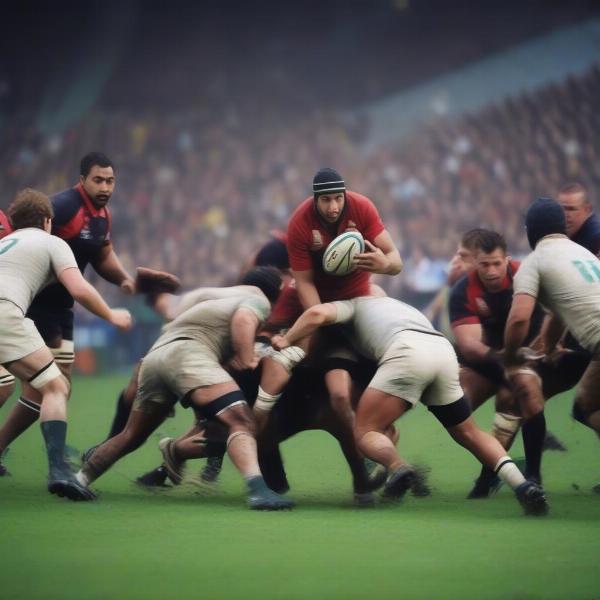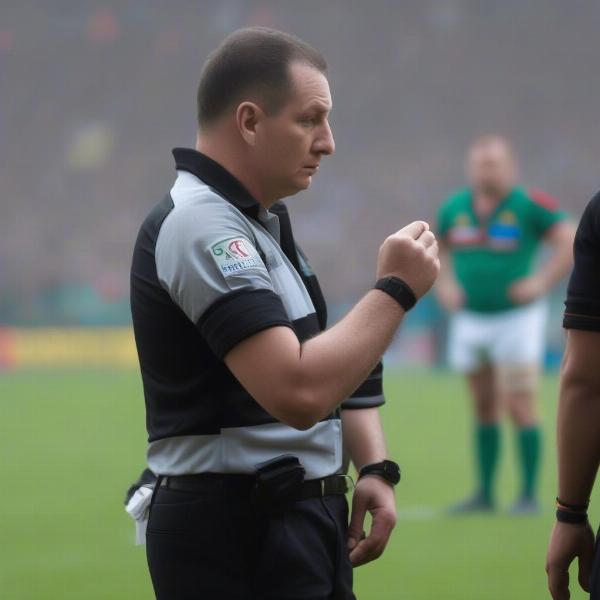A rugby game is divided into two halves, not quarters. Understanding this fundamental difference between rugby and other sports like American football or basketball is crucial for anyone new to the sport. While the term “quarter” is often used colloquially, it’s technically incorrect. Let’s delve deeper into the structure of a rugby match and dispel some common misconceptions.
Decoding Rugby’s Time Structure: Halves, Not Quarters
Unlike sports with four quarters, a standard rugby game consists of two 40-minute halves. This means 80 minutes of exhilarating action separated by a short half-time break, typically around 10-15 minutes. This structure contributes to rugby’s unique flow and strategic demands, requiring players to manage their energy and tactical approach over a longer, more continuous period. While there are breaks in play for injuries, scrums, and other stoppages, the clock doesn’t stop in the same way it does in American football. This continuous play adds a layer of complexity and excitement to the game.
Why the Confusion with Quarters?
The term “quarters” might creep into casual conversations about rugby, often due to the influence of other popular sports. It’s important to remember that officially, rugby utilizes halves. Perhaps the misunderstanding stems from the fact that each half in rugby could be seen as two 20-minute periods, mirroring the concept of quarters. However, the game is structured around two distinct halves, and this distinction is important for understanding the rules, strategy, and overall flow of a rugby match.
 Rugby Game Halves, Not Quarters
Rugby Game Halves, Not Quarters
Beyond the Halves: Extra Time and Stoppage Time
While the core of a rugby match is its two halves, there are situations where the game extends beyond the 80-minute mark. Extra time is utilized in knockout competitions if the scores are tied at the end of regulation. This extra time period typically consists of two 10-minute halves, further emphasizing the importance of stamina and strategic decision-making. Additionally, stoppage time is added at the end of each half to account for significant interruptions like injuries or substitutions. The referee determines the amount of added time, ensuring a fair and complete contest.
Understanding Stoppage Time in Rugby
Stoppage time, sometimes referred to as “injury time,” is a crucial element in how many minutes are actually played in a rugby game. Unlike some other sports, the clock continues to run during most stoppages in rugby. However, the referee keeps track of any significant delays and adds this time to the end of each half. This ensures that the full allotted time is played, even with interruptions.
 Rugby Stoppage Time and Extra Time
Rugby Stoppage Time and Extra Time
The Impact of Halves on Gameplay
The two-half structure significantly influences rugby’s strategic dynamics. Teams must carefully manage their player rotations, energy levels, and tactical adjustments throughout the entire 80 minutes. The continuous nature of play, with limited stoppages, requires a high level of fitness and strategic thinking. Unlike sports with more frequent breaks, rugby demands sustained effort and adaptability, making it a truly demanding and engaging sport.
Strategic Considerations in Rugby’s Two Halves
The longer halves in rugby require coaches and players to develop nuanced game plans. The first half often focuses on establishing dominance and building a lead, while the second half necessitates adjustments based on the opponent’s strategy and the current score. Effective player substitutions and tactical shifts become crucial for maintaining momentum and securing victory.
“Managing player fatigue and making timely substitutions are critical in rugby. The two-half format demands strategic thinking regarding player deployment and energy conservation throughout the 80 minutes,” says renowned rugby coach, William “Bill” Thompson.
Other Key Time Elements in Rugby
While the two halves form the backbone of a rugby match, there are other time-related aspects to consider. For example, conversions and penalty kicks have specific time limits for execution. Understanding these rules and regulations adds another layer to appreciating the intricacies of the sport.
Time Restrictions on Conversions and Penalties
Following a try, the converting team has a limited time to attempt the conversion kick. Similarly, penalty kicks also have a time limit for execution. These time constraints add pressure and excitement to the game, showcasing the players’ skill and composure under pressure.
“The pressure of executing a conversion or penalty kick within the allotted time adds a significant psychological dimension to the game,” notes sports psychologist Dr. Sarah Chen.
 Rugby Conversions and Penalties Time Limits
Rugby Conversions and Penalties Time Limits
Common Misconceptions about Rugby Timekeeping
Many newcomers to rugby confuse its structure with that of American football. It’s vital to clarify the distinction between halves and quarters to fully grasp the game. This understanding allows for a more accurate interpretation of the rules, strategies, and the overall flow of the match.
Conclusion: No Quarters, Just Two Halves of Intense Action
So, How Many Quarters Are In A Rugby Game? The answer is none. A rugby match is played in two 40-minute halves, not quarters, creating a unique flow and requiring a different strategic approach than sports with four quarters. Understanding this key difference is fundamental to appreciating the nuances of rugby and its demanding nature. From stoppage time to extra time, the time element in rugby adds layers of complexity and excitement to this thrilling sport. Now that you understand this fundamental aspect, you’re ready to dive deeper into the world of rugby! Share this information with other rugby enthusiasts and help dispel the quarters myth!
FAQ
-
What is the length of a rugby half? Each half in a standard rugby game is 40 minutes long.
-
Is there stoppage time in rugby? Yes, stoppage time is added at the end of each half to compensate for interruptions in play.
-
How long is half-time in rugby? Half-time typically lasts 10-15 minutes.
-
How does extra time work in rugby? In knockout competitions, extra time consists of two 10-minute halves if the scores are tied after regulation.
-
Why is it important to understand the difference between halves and quarters in rugby? Understanding this difference is crucial for grasping the game’s rules, strategies, and overall flow.
-
What are some common misconceptions about rugby timekeeping? One common misconception is that rugby games are divided into quarters, similar to American football.
-
Where can I learn more about the rules of rugby? You can find detailed information about rugby rules on the official World Rugby website.

